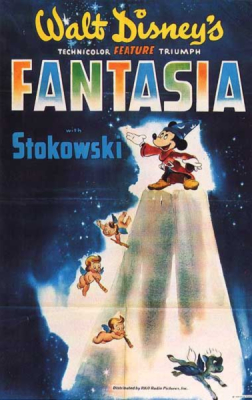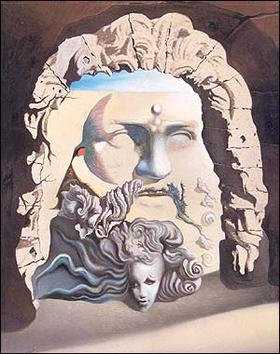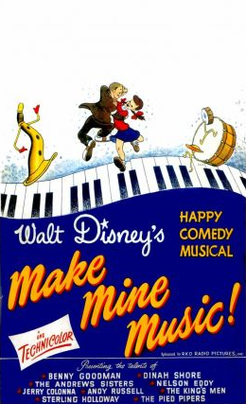Related Research Articles

Walter Elias Disney was an American animator, film producer, voice actor, and entrepreneur. A pioneer of the American animation industry, he introduced several developments in the production of cartoons. As a film producer, he holds the record for most Academy Awards earned (22) and nominations (59) by an individual. He was presented with two Golden Globe Special Achievement Awards and an Emmy Award, among other honors. Several of his films are included in the National Film Registry by the Library of Congress and have also been named as some of the greatest films ever by the American Film Institute.

Fantasia is a 1940 American animated musical anthology film produced by Walt Disney Productions, with story direction by Joe Grant and Dick Huemer and production supervision by Walt Disney and Ben Sharpsteen. It consists of eight animated segments set to pieces of classical music conducted by Leopold Stokowski, seven of which are performed by the Philadelphia Orchestra. Music critic and composer Deems Taylor acts as the film's Master of Ceremonies who introduces each segment in live action.

The golden age of American animation was a period in the history of U.S. animation that began with the popularization of sound synchronized cartoons in 1928 and gradually ended in the 1960s when theatrical animated shorts started to lose popularity to the newer medium of television. Animated media from after the golden age, especially on television, were produced on cheaper budgets and with more limited techniques between the late 1950s and 1980s.

The Walt Disney Studios, located in Burbank, California, United States, serves as the corporate headquarters for The Walt Disney Company media conglomerate. The 51-acre studio lot also contains several sound stages, a backlot, and other filmmaking production facilities for Walt Disney Studios's motion picture production. The complex also houses the offices for the company's many divisions, with the exception of Pixar Animation Studios, Lucasfilm, and 20th Century Studios, which remains on its namesake lot in nearby Century City as tenants of Fox Corporation.
The history of animation, which is the method for creating moving pictures, has an early history and modern history, beginning in 1888 with the advent of celluloid film. The main focus of this article the history of animation post-1888.
The silent age of American animation dates back to at least 1906 when Vitagraph released Humorous Phases of Funny Faces. Although early animations were rudimentary, they rapidly became more sophisticated with such classics as Gertie the Dinosaur in 1914, Felix the Cat, Oswald the Lucky Rabbit, and Koko the Clown.

Destino is an animated surrealist short film released in 2003 by Walt Disney Animation Studios1. Destino is unique in that its production originally began in 1945, 58 years before its eventual completion in 2003. The project was originally a collaboration between Walt Disney and Spanish painter Salvador Dalí, with music written by Mexican songwriter Armando Domínguez and performed by Mexican singer Dora Luz as the sound track. It was included in the Animation Show of Shows in 2003.

Traditional animation is an animation technique in which each frame is drawn by hand. The technique was the dominant form of animation, until the final few years of the 20th century, when there was a shift to computer animation in the industry, specifically 3D computer animation.

Fantasia 2000 is a 1999 American animated musical anthology film produced by Walt Disney Feature Animation and released by Walt Disney Pictures. Produced by Roy E. Disney and Donald W. Ernst, it is the sequel to Disney's 1940 animated feature film Fantasia. Like its predecessor, Fantasia 2000 consists of animated segments set to pieces of classical music. Segments are introduced by celebrities including Steve Martin, Itzhak Perlman, Quincy Jones, Bette Midler, James Earl Jones, Penn & Teller, James Levine, and Angela Lansbury in live action scenes directed by Don Hahn.

Walt Disney Animation Studios (WDAS), sometimes shortened to Disney Animation, is an American animation studio that creates animated features and short films for The Walt Disney Company. The studio's current production logo features a scene from its first synchronized sound cartoon, Steamboat Willie (1928). Founded on October 16, 1923, by brothers Walt Disney and Roy O. Disney after the closure of Laugh-O-Gram Studio, it is the longest-running animation studio in the world. It is currently organized as a division of Walt Disney Studios and is headquartered at the Roy E. Disney Animation Building at the Walt Disney Studios lot in Burbank, California. Since its foundation, the studio has produced 62 feature films, from Snow White and the Seven Dwarfs (1937) to Wish (2023), and hundreds of short films.

Myron "Grim" Natwick was an American artist, animator, and film director. Natwick is best known for drawing the Fleischer Studios' most popular character, Betty Boop.

Make Mine Music is a 1946 American animated musical anthology film produced by Walt Disney and released by RKO Radio Pictures on April 20, 1946.

Melody Time is a 1948 American live-action and animated musical anthology film produced by Walt Disney. It was released to theatres by RKO Radio Pictures on May 27, 1948. Made up of seven segments set to popular music and folk music, the film is, like Make Mine Music before it, the popular music version of Fantasia. Melody Time, while not meeting the artistic accomplishments of Fantasia, was mildly successful.

Wolfgang Reitherman, also known and sometimes credited as Woolie Reitherman, was a German-American animator, director and producer and one of the "Nine Old Men" of core animators at Walt Disney Productions. He emerged as a key figure at Disney during the 1960s and 1970s, a transitionary period which saw the death of Walt Disney in 1966, with Reitherman serving as director and/or producer on eight consecutive Disney animated feature films from One Hundred and One Dalmatians through The Fox and the Hound.
Joseph Clarence Grant was an American conceptual artist, storyboard artist, and screenwriter.
Simply Mad About the Mouse: A Musical Celebration of Imagination is a 1991 direct-to-video release showcasing top contemporary singers performing classic Disney songs. Released on September 27, 1991, this 35-minute feature consists of a series of music videos available on VHS and LaserDisc. The music videos were exclusive to the video and the Disney Channel.

The Little Matchgirl is a 2006 animated short film produced by Walt Disney Animation Studios and released by Walt Disney Pictures, directed by Roger Allers and produced by Don Hahn. It is based on an original 1845 story of the same name by Hans Christian Andersen. It is the fifth Disney adaptation of an Andersen tale. It was nominated for the Academy Award for Best Animated Short but lost to The Danish Poet at the 79th Academy Awards.
The second wave of Walt Disney Treasures was released December 3, 2002. This was the final wave with the tin's individual number embossed on the tin.

Wilfred Emmons Jackson was an American animator, musical arranger and director best known for his work with Walt Disney Productions.

Fantasia is an American media franchise owned by The Walt Disney Company that commenced in 1940 with the theatrical release of the film of the same name.
References
- ↑ Cotter, Bill (1997). The Wonderful World of Disney Television. Hyperion Books. pp. 161–162, 547. ISBN 0-7868-6359-5.
- ↑ "Makin' 'Em Move: Rare Behind the Scenes Footage of Vintage Animation Studios", Thunderbean, http://www.thunderbeananimation.com